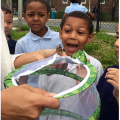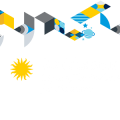From the Secretary: Creating a community of learners
President Obama’s BlackBerry and Abraham Lincoln’s “T-mails” (telegraph transmissions) offer us symbols of new technology’s transformational impact. This month’s exclusively online Torch edition marks a milestone in the Smithsonian’s adoption of new technologies to improve communication to internal and external audiences.
New technology and social networks can help us reach younger generations. The Smithsonian’s use of new media—blogs, Twitter, YouTube, podcasts and Flickr—is already widespread. As we inspire larger audiences through these additional platforms and vehicles, we can enter into a dialogue that freely shares information. By increasing access to our collections and other resources, the relevance of the Smithsonian to education can be magnified many times over.

This brass inkstand is from the desk of Major Thomas Eckert in the War Department telegraph office. Abraham Lincoln composed an early draft of the Emancipation Proclamation while sitting at Eckert’s desk in 1862.
Pilot projects allow us to experiment and take risks in the ways we expand the depth and breadth of our out-reach. The success of our first Smithsonian Education Online Conference on Feb. 4 and 5—focused on Abraham Lincoln—is a good example. Harry Rubenstein, curator of “Abraham Lincoln: An Extraordinary Life” at the American History Museum, shared 16 artifacts from the exhibition. The brass inkstand that sat on a desk in the War Department’s telegraph office—where Lincoln came almost daily to get battlefield news, send messages to his generals and work in a quiet space—prompted lively discussion among conference participants.
During the summer of 1862, Rubenstein explained, President Lincoln used the inkstand as he drafted what he told the officer at whose desk he was working was “an order freeing the slaves of the South.” This inkstand is not simply an interesting antique, it is one of those iconic objects that connect us to a moment that changed the life of the nation—the writing of the Emancipation Proclamation.
The conference already has reached an audience of more than 4,000 high-school teachers, students, librarians and others in 69 countries. The discussion continues with archived content and virtual exhibits at www.smithsonianeducation.org.
The inkstand is only one of many other Smithsonian artifacts illuminating Lincoln’s life that are online through the pan-Institutional Connections Project at www.goSmithsonian.com/SIConnections. Both the Connections Project and the online conference support the conclusions of a recent National Research Council report on informal science education that emphasizes the value of museum exhibitions, collections, interactive dialogue and group participation.
The huge potential of informal education is within our grasp through online interactions with curators, historians and other scholars. Web technologies can make geographical distances disappear as teachers and students all over the world learn from each other. In addition, as we have recently seen, teachers are developing lesson plans from our virtual offerings, and sharing them with us and others. Such sharing amplifies our potential impact enormously and also helps us learn how to shape our presentations to best assist teachers.
Educators in my hometown of Douglas, Ga., (metro pop. about 50,000) have joined this ever-growing Smithsonian community of learners. As one Douglas High School teacher said of the online Lincoln conference: “Most valuable to my students (and to me) were the responses to several of our comments. In high school lingo, that was ‘cool.’” We look forward to welcoming even more teachers and students to our next online conference in the fall about climate change.
G. Wayne Clough is the 12th Secretary of the Smithsonian Institution.
Posted: 1 May 2009
- Categories:







